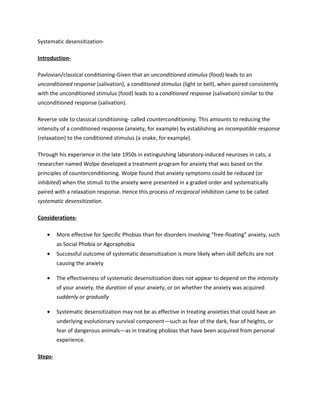
Systematic desensitization
- 1. Systematic desensitization- Introduction- Pavlovian/classical conditioning-Given that an unconditioned stimulus (food) leads to an unconditioned response (salivation), a conditioned stimulus (light or bell), when paired consistently with the unconditioned stimulus (food) leads to a conditioned response (salivation) similar to the unconditioned response (salivation). Reverse side to classical conditioning- called counterconditioning. This amounts to reducing the intensity of a conditioned response (anxiety, for example) by establishing an incompatible response (relaxation) to the conditioned stimulus (a snake, for example). Through his experience in the late 1950s in extinguishing laboratory-induced neuroses in cats, a researcher named Wolpe developed a treatment program for anxiety that was based on the principles of counterconditioning. Wolpe found that anxiety symptoms could be reduced (or inhibited) when the stimuli to the anxiety were presented in a graded order and systematically paired with a relaxation response. Hence this process of reciprocal inhibition came to be called systematic desensitization. Considerations- • More effective for Specific Phobias than for disorders involving “free-floating” anxiety, such as Social Phobia or Agoraphobia • Successful outcome of systematic desensitization is more likely when skill deficits are not causing the anxiety • The effectiveness of systematic desensitization does not appear to depend on the intensity of your anxiety, the duration of your anxiety, or on whether the anxiety was acquired suddenly or gradually • Systematic desensitization may not be as effective in treating anxieties that could have an underlying evolutionary survival component—such as fear of the dark, fear of heights, or fear of dangerous animals—as in treating phobias that have been acquired from personal experience. Steps-
- 2. 1. Relaxation; 2. Constructing an anxiety hierarchy; 3. Pairing relaxation with the situations described in your anxiety hierarchy. Relaxation- Before performing systematic desensitization it will be necessary to become familiar with some form of relaxation technique. – deep breathing, jacobson’s muscle relaxation, etc. Creating a hierarchy- 1. Create about 16 or 17 situations at the beginning. 2. We may discard some items in the sorting process, so you can expect to end up with about 10 to 15 items in your final hierarchy. To aid in sorting the items, write each one on a separate index card. 3. The situations or scenes in your hierarchy should represent a fairly well-spaced progression of anxiety. The best way to achieve this goal is to first grade the anxiety of each item by assigning it a number on a scale from 0 to 100, where 100 is the highest level of anxiety imaginable and 0 is no anxiety (complete relaxation). 4. When each item has an anxiety grade, your next step will be to sort them into 5 piles. Each pile will represent a different category of anxiety, as follows: Pile Anxiety Grade Low Anxiety 1–19 Medium Low Anxiety 20–39 Medium Anxiety 40–59 Medium High Anxiety 60–79 High Anxiety 80–100 The goal here is to end up with at least two items in each pile. If not, you will have to go back and re-evaluate some items or create some new items. Pairing relaxation with the situations described in your anxiety hierarchy-
- 3. • Practice systematic desensitization in the same environment you use to practice relaxation. • Your systematic desensitization sessions should not exceed 30 minutes. • Also, you should not attempt to desensitize yourself to more than three of your anxiety hierarchy items per session. • Each session (except the very first one, of course) should begin with the last item from your previous session. That is, if the last item was successfully desensitized, then you should review it in the next session, and if it was not successfully desensitized, then you should begin with it in the next session. Problems- You might encounter either of two major problems during systematic desensitization: • You might experience no anxiety at the presentation of an item. CAUSE SOLUTION The situation is not being imagined vividly Describe the situation in greater detail. enough. or Imagine the scene for a longer period of time. The situation induces a lower level of Describe the situation in greater detail. anxiety than a previous item. or Eliminate this item. • You might be unable to decrease a high level of anxiety even after numerous cycles. CAUSE SOLUTION The situation has not been placed in the Develop a new item to be placed before appropriate order in your hierarchy. this item. or Place this item later in your hierarchy.
- 4. The situation is so embellished that it contains Rewrite the description of this item. elements of scenes later in your hierarchy. You are focusing on a scene too long for the Decrease the amount of time imagining the intensity of anxiety it has the power to scene. produce. or Rewrite the item to break it into two new items. Conclusions- Practice this regularly. Research shows long standing effects.
